Dimensions
Space Perception in Alexander Sokurov’s Mother and Son (Mat i syn, 1997)
Vol. 9 (September 2011) by Moritz Pfeifer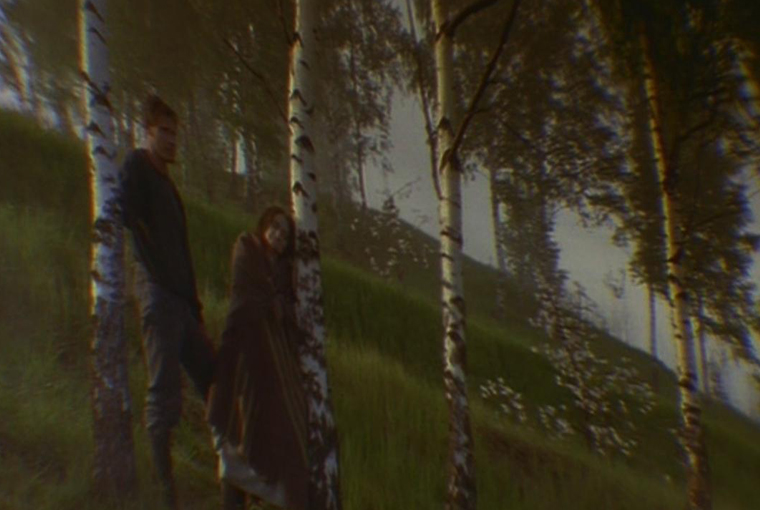
Perspective, projection, introjection
Alexander Sokurov’s Mother and Son is a son’s farewell to his dying mother. The mother is old and sick, and they spend the rest of her life in what looks like the ruin of a nineteenth century country house. It seems as though time stopped moving a long time ago in this meditative retreat, miraculously prolonging the mother’s death. As they talk about death and afterlife, and share dreams and memories, the mother’s impending death consternates neither one of them. Life fades away slowly and maybe painfully, but without fear or agony. When there is nothing more to be said, the son leaves the house to let his mother do the dying. In the end, everybody has to die alone.
The most remarkable aspect of Mother and Son is its images. They are blurred, distorted, and lack depth. Most of the time it is difficult to make out whether the characters are behind, in front of, or in between a row of birch trees for example (fig. 1). Some critics have alluded to the film’s painting-like aspect, evoking the German Romantic painter Caspar David Friedrich. This comparison is surely understandable, yet regarding depth perception, in Friedrich’s paintings, background and foreground are clearly distinguishable. Of course, screen and canvas are always two-dimensional, but in Sokurov’s film the illusion of a three-dimensional space is missing. As large parts of the film’s sequences are anamorphic, the image appears like a flat surface which, technically speaking, is true for every film. But other films, or a C.D. Friedrich painting for that matter, do not give the impression of being watched from a “wrong” perspective. The trick is that depth or at least the illusion of it, could still be perceived in Sokurov’s film with the help of an imagined turn (of about 45° to the right) that would correct the point of view of the picture (fig. 2). Now all of a sudden it is clear that the two trees, and mother and son, are actually next to each other, not behind each other (notice that sky and horizon, which in the original image seem to open up somewhere on the left side of the characters, are now actually behind them).
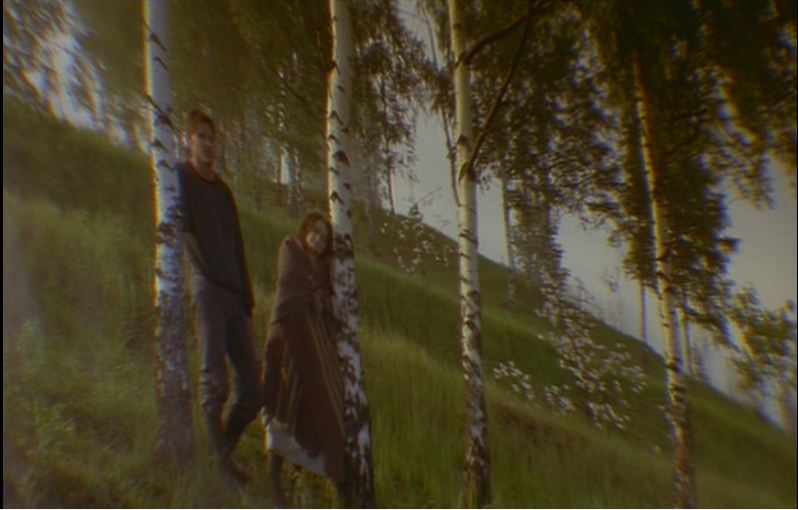
Fig. 1: Sokurov: Mother and Son – birch trees – 00’30’46
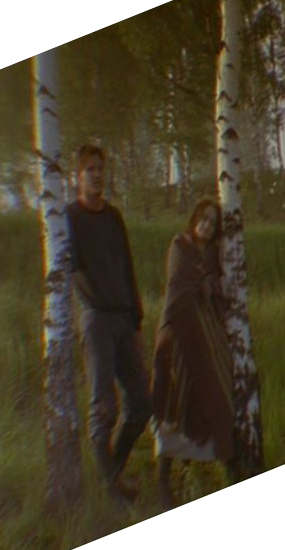
Fig. 2
So in Sokurov’s film, horizon and objects collapse, the world looks flat and awry. C.D. Friedrich’s perception of the world, on the contrary, is very similar to normal space perception – there is no need to make imagined turns to understand where objects are located. The only aspect that could relate C.D. Friedrich’s landscapes to Sokurov’s film, seems to be their melancholy. But here too, the two artists proceed differently. If C.D. Friedrich is a dreamer, his dreams are projected onto the world. For C.D. Friedrich, everything happens outside of the mind – but not objective. Despite the exteriorization of phenomena, the world actually remains subjective. C.D. Friedrich’s illustration of trees (fig. 3) for example, are inseparable from the feelings and thoughts created by them, but these feelings and thoughts are placed into the trees, and are not conceived as a product of subjectivity. The trees can thus stand for all sorts of mental conditions – grief, continuity, nostalgia and so on – but in the end they also show quite a realistic depiction of nature. Someone might consider for example that C.D. Friedrich’s trees are the ultimate reflection of his personal loneliness, but still he’s just looking at a bunch of trees. This confusion is the projectionist’s signature. For the projectionist, things only appear in a different (actually his own) light, although they stay the same (actually different).
Sokurov’s oneiric space, on the contrary, is introjected. To introject trees, is to put trees in place of the self. Sokurov’s trees (fig. 4) look as though they could not exist without the hallucinative fog obscuring them. If C.D. Friedrich’s question is “Why does the tree feel like I do?”, Sokurov asks “Why do I feel like a tree?” The project of Sokurov’s film is to localize inside the mind what takes place outside of it.

Fig. 3: Caspar David Friedrich: Giant Grave by the Sea

Fig. 4: Sokurov: Mother and Son – Forest – 1’00’40
The difference between introjection and projection can thus be compared to two distinct forms of perspective. The activity of projection, in which dreams, desires, and feelings are dislocated from the subject, is represented by the illusion of infinite space. Here, everything is moving away from the subject. This activity is reflected by the never ending horizon in Friedrich’s paintings. Projective perspective is depth, because its goal is to penetrate the profundity of the outside space. C.D. Friedrich’s landscapes become infinite because we are so small, they becomes deep because our feelings are so profound…It is important to note, however, that projection does not involve an invasive gesture. The contemplating people in Friedrich’s paintings, always looking away from the viewer and into the picture, still maintain a distance towards the things they see. The paradox is that they might open themselves up to the outside and long for an experience of their own presence elsewhere, but the outside world never really changes. It’s as though the dream is more valuable than the realization of it. Thus the point of projection is not for the object to disappear, or to completely metamorphose into the subject’s version of it. This would eradicate the object. A minimum of separation has to persist, so that the fascination for the changing object – from tree to loneliness, etc. – can be enjoyed. The only “object” threatened to disappear is thus the subject. Is not the Monk by the Sea in danger of being squeezed into the ocean by seashore and sky?
Projection and introjection are not contradictory because both scenes confuse external and internal activity. In projection one is absorbed in things, in introjection one absorbs things – but either way, the subject looses its own locality. In introjection, however, the perspective is reversed. Instead of moving away from the subject, introjective perspective collapses, and falls into the subject, providing a distorted perception of space. Medieval painters mastered introjective perspective. While C.D. Friedrich’s vanishing point moved towards infinite space, that is, away from the observer, perspective lines in medieval iconography move towards the foreground of the image. Take a look at Cimabue’s depiction of the Madonna and Child (fig. 5), to see how objects tend to collapse in front of the image, right where the person looking at the picture is located.
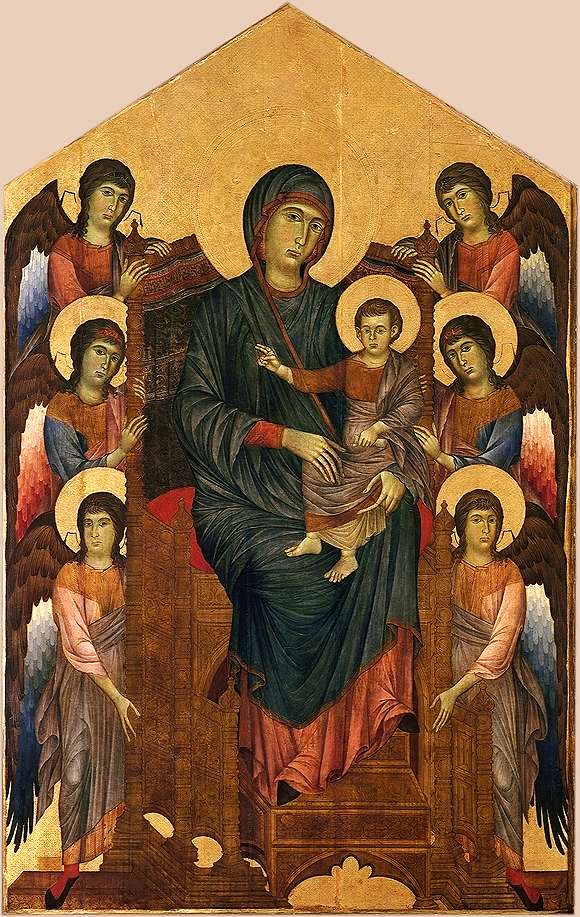
Fig. 5: Cenni DI PEPE, known as CIMABUE The Madonna and Child in Majesty Surrounded by Angels c. 1280
In Cimabue’s painting, the chair’s perspective is reversed. This means that the vanishing point is located in front of the picture. Objects get bigger on approaching the horizon, and smaller when they are close. This is precisely the introjectionist’s perspective. He reduces the outside world to himself. The interesting thing about the vanishing point that the Renaissance invented, is that it is placed outside, at a place that the subject creating the vanishing point will never reach. In other words, the vanishing point is projected. But in order to draw a simple three-dimensional space with such a vanishing point, an infinite universe has to be implied. The medieval introjective perspective, on the contrary, has it that “if a person would stretch out his hand beyond the convex sphere of heaven, the hand would occupy no position in space nor any place, and in consequence would not exist.” Indeed, this solipsistic perspective cannot think of a point of view that is not its own. Giordiano Bruno, who wrote these lines in reference to a Pre-Modern perception of space, was one of the first thinkers to accept that the world is not the universe, that the hand would not disappear if it would reach beyond the horizon. For Bruno, God might as well be the creator of similar worlds elsewhere. Whatever else might exist, “outside” and “inside” worlds are equal before God, and our world is only a small engine amidst innumerous other suns and stars scattered in the sky.
Bruno’s acceptance of different worlds is not the perspective of iconography, or of an anthropocentric conception of the universe. The crucial point, however, is that if everything is sucked in, there can be no depth or horizon. In iconography, there is no perspective “on” things, only a confused impression of various contradicting localities. Thus the angels surrounding the Madonna and her Child do not get bigger, even though they are supposed to stand behind each other. They are exempted from the reversed perspective of the throne. The Child seems to float on his Mother’s lap. Impossible to tell whether his legs are resting on her knees or not. For the introjectionist, the world is flat because to have a perspective is to be able to differentiate between oneself and objects, and to perceive in what way they are related to each other. In other words, the outside world exists on a single level because of the confusion between internal and external experiences.
Disorientation makes iconography appear childish. Children permanently confuse between themselves and others, and vice versa. They only gradually become conscious of their subjectivity. For children, nothing is spatially fixed, and objects are immediately encountered while everything else is blinded out. So even if there is no depth perspective, objects still have a subjective proportion. They are measured according to importance, power, or other affective (solipsistic) properties. Introjection enlarges the subject. The introjecting subject expands and propagates while accumulating exterior objects within itself. It does therefore not seem strange that in most iconographies, Jesus doesn’t look like a child at all, but more like a miniature version of a full grown man. Similar to the child who acts like an adult when playing, but appears more convincing than its adult models, the real parental figure in this painting is baby Jesus, performing the sign of the cross as if he would be in the position to bless/protect other people, even though it seems impossible for him to know where or who those other people are. But if little Jesus is confused with an adult, Mary seems monstrously oversized, which in turn leads back to the feeling of an omnipresent maternal realm. If C.D. Friedrich’s monk was thus threatened with being squeezed into the painting, the child in iconography, staying remote from the objects surrounding it, is like a cloak – always in danger of falling out of the surface. It is given no room.
Ironically, what is lacking in iconography is some sort of God-like element. Only a distant “father” could separate mother and child and establish a proper distance between the two (note that before Christianity, the Romans were able to localize their painted subjects in space, and that there is not one known Roman painting showing a mother with her child). The iconographic child is not yet confronted with an object (God) that could delimitate the space of its identification, and thus confront it with an image that would alienate it from itself (“My God, my God, why have you forsaken me?”). In my view, this was also the point in Father and Son, Sokurov’s follow-up to Mother and Son. In this later film, the depiction of a male-male relationship is actually centered around absent women. The same lack seems to come out of Mother and Son (and the “Madonna and Child” theme in iconography), only that here, the missing detail is the father/God/other, whose presence could establish the plot for a world lying outside of the self.
Mourning, Bread, Wine
Like Cimabue’s iconography, Mother and Son portrays a “flat” perception of the world. In some sequences, the son fuses into the mother, as if sucking her up (introjecting her). Towards the end of the film, when the son returns to the house and finds his mother’s dead body, they gradually disintegrate until their bodies look like an abstract blur (figs. 5 and 7). Here too, the son expands, though not in time (as in the iconography, where Jesus got older but stayed a child) but in space (the son enlarges but seems to regress into an ultrasonic image of a baby).

Fig. 6: 1’03’08

Fig. 7:1’03’08
The disappearance of the son’s body, his becoming a ghost, is the drama in Sokoruv’s film. Until now, this reading of Sokurov’s film has only taken into account an infantile perception of the world. In psychoanalytically based theory (Melanie Klein, Freud, Mariá Török, Judith Butler, and others) introjection is usually associated with mourning (I draw here on Judith Butler’s interpretation of mourning, especially her attempts to link mourning with doubt). Since loss and mourning are also at the center of Mother and Son, it might be useful to ask how introjective perception is related to death. But it is important not to dismiss what has been said about iconography, suffice it to say that one of the fundamental axes of Christian theology is mourning (in opposition to ancient Greek society for example, where mourning was left to woman and expulsed from the public sphere). Is Christianity not built upon the introjection of a dead body? 1 Corinthians 11:27 : “Whoever, therefore, eats the bread or drinks the cup of the Lord in an unworthy manner will be guilty concerning the body and blood of the Lord.”.
One way to escape the traumatic experience of loss is to introject the lost object, and pretend that it is still living as an appropriated feature of one’s own psyche. It has already been shown how this introjectory process works in the final sequence of Sokurov’s film, with mother and son merging into a single blur. The dialogs too, allude to the son’s denial of his mother’s death, for example when he tells her that she is not going to die, or that she can live as long as she likes. Another indication of the continuation of her life is the butterfly (on the mother’s dead hand in figs. 6 and 7), a Christian symbol for immortality, and trademark of the Greek goddess Psyché.
The problem of introjecting the dead is similar to that of transubstantiation. Where does the introjected body go? Is the body only an immaterial spirit (butterfly) or a physical substance (caterpillar)? If the body is only a ghostly sign, the subject would have to believe in its own hallucinations. It could then only experience the dead body in an imaginary way, succumbing to an objectless world. On the other hand, introjecting a substantially dead body is equally problematic because the chance for it to survive within the subject is impossible. Literally, the physically present substance would disappear if it be consumed (digestion, etc.). What’s more, if introjection is based upon the realization of a cannibalistic fantasy, (a psychic activity experienced as substantial), the subject can only blame itself for the loss of the object. “Whoever, therefore, eats the bread or drinks the cup of the Lord in an unworthy manner will be guilty concerning the body and blood of the Lord.”
So the mourning subject has two choices: either it perishes with the taking in of the object, or the good-willed preservation of the object will appear to the subject as its own murderous coup. In other words, either it fully introjects the dead person, and dies itself, which would mirror a transubstantialist’s account of introjection (where bread has to give in to Christ’s body), or it introjects the object and survives, thus also experiencing the loss of it, which reflects the substantialist’s version (where bread stays bread, and Christ stays Christ, which, in short, seems like a prosaic compromise). The choice of the transubstantialist reiterates what has been already said about the infant’s experience of introjection. Introjection in mourning exchanges the subject with the object, giving the subject no room. In return, becoming aware of itself, the child undergoes a similar experience to the guilty feeling introjectionist, when it realizes that it cannot possibly imitate/identify with everything outside of it. For example the child feels frustrated because it cannot reach some desired object. Upon giving the object to the child, it might violently throw the object away. Becoming aware that it did not get into the possession of the object by its own means, the child punishes its own identificatory mistake, projecting an aggressive sanction onto the object. The crucial point is that through this moralizing activity, the object is still introduced into the subject, the only difference being that the subject fails to claim ownership of it. It is thus forced to separate inner and outer worlds.
If the hungry substantialist asks “How can a piece of bread turn into Christ’s body?”, thereby becoming conscious of a problem in his view on the world, the mourner begins to doubt his reasons for mourning asking “How can I loose what I seek to preserve?” Mourning is an ambivalent activity. In mourning, the subject comes to reenact death. It has already been said how introjection produces the object’s second death. But repetition can also help the subject grasp what it could or would not understand (an event happening without its own involvement) and thus save it from getting lost itself. The subject is thus urged to correct his confusion about himself and the dead object, the moment it realizes that it has miraculously survived the introjection of the object, and that his own body somehow resisted consumption. The subject becomes conscious when things clash, when it has to experience that the loving gesture of wanting to keep the dead object alive actually lead to the destruction of it. The starting point for the sense of subjectivity is thus doubt or even guilt, as the subject blames itself for having only pretended to preserve the loved object from dying, letting it die nonetheless. Torn between contradicting shifts of affections, the subject has the possibility to fall back into place. One could say that the subject is confronted with a very Cartesian scene. As is well known, for Descartes doubt is the first affirmation (proof) of the existence of the subject. Descartes’ famous cogito is based upon the realization that in order for someone to doubt, and thus think that everything he perceives is false, illusionary, etc., that person already presupposes the existence of himself (as a doubting being). Doubt is thus the subject’s survival in the mourning scene.
It is not clear if the son is able to establish this self-reflexive distance, and consequentially, if he is able to let his mother go. One of his last words to her is “We will meet where we agreed.” From the rest of their dialogue, it is impossible to figure out where exactly this meeting place is. And in regards to what has already been said about the film’s images, mother and son have already joined each other in one and the same place. This makes his words sound like a plea for an eternal rendezvous. The crypt-like house they are dwelling in also enhances the son’s attempts to preserve his dead mother, not to perform the murder against mourning, and thus not to emerge from the scene of introjection with the undoing of the introjective bind. Mariá Török along with Nicolas Abraham came up with the term “psychic crypt” to describe the place of the living dead within the subject. In this crypt, the dead are kept alive, complete and untouched, but not as living. The crypt preserves the dead, as dead, precisely to avoid the introjective work of mourning, in which the dead object gets destroyed, and where the dead object had to be considered living in order to fully die. Cryptic introjection thus refuses mourning, while at the same time introjecting never stops.
There definitely is a cryptic side to Mother and Son. In the enigmatic conversation about nightmares that opens the film, mother and son share feelings of ghostly anxiety:
“Mother and Son: I am seized by a suffocating nightmare. And I am stricken with terror and awake covered in sweat. God, dwelling in my soul, affects only my consciousness. He never extends beyond me to the outer world…to the course of things.”
Something is tormenting their soul, but it is never acted out. It never extends towards the body, thus only affecting their consciousness. Whatever God is working on them (a punishing God, a loving God), the transformations He triggers are not projected onto the “outer world.” Once more, what can be observed in these opening lines is the crux of the film: the disintegration of physical bodies into pure psychic mass, the foreclosure of an outside world at the cost of the subject’s spatial presence. But still one can ask whether “nightmare”, “terror”, and exclusion from “the outer world” are only the character’s impartations of what is happening on screen, or whether there actually is a self-reflective side to these statements. It has been noted that doubt is one of the first feelings one can have towards subjectivity. As it is, the two characters seem to be aware of the fact that they are tormented, and punished, and that there is something inside of them that is giving them a reason to be ashamed. These things that are inside – nightmares, aggression, terror – clash with the perceived physical harmony of caring (for example the pietà-like carrying of the mother as they go for a walk). The simultaneous presence of terror and pity, suffocation and preservation, etc. might then be the key to the son’s separation from his mother and introjection might not proceed as smoothly, as it may seem.
The son abandons the Crypt the moment his mother dies. From what has been said so far, it would make sense to conclude that the reason for his departure is to escape the death of his mother, and consequently postpone the necessary work of mourning that would separate him from the dead (destructive repetition, awareness of repetition’s failure, separation). However, it is also outside of the crypt, while his mother is dying, that he sees the landscapes reminiscent of C.D. Friedrich. With all that has been said about C.D. Friedrich, the images the son sees – ocean, forest, mountains – can thus be read as the refusal to play the cryptic game of mourning. Maybe escaping the crypt is the son’s attempt to recreate a world of objects, even if they correspond to his subjective perception. But the son closes his eyes after looking at the forest, so something in the horizon didn’t convince him to stay there. Essentially mourning vacillates between the failures of two impossibilities: the impossibility of letting a tree do the mourning, and the impossibility of turning into a mourning tree. But only when identification fails can the subject become aware of its difference. Thus instead of building a kind of non-place of mourning, these alternating failures establish the grounds for a livable position in space.
The most obvious sign for the son’s refusal to transmute into a bodiless introjecting mass, can be seen in his hesitant attempt to squeeze the butterfly on his mother’s hand. If the son is trying to kill the butterfly (psyché), is he not also trying to resist the self-diminishing effect of introjection happening simultaneously to his head above hand and butterfly? But he is not sure whether to kill it or not, quickly moving his hand away from the insect, as if afraid that he would harm it (and the soul of his dead mother). Here again, benevolent mind-introjection clashes with consuming body-introjection. The son’s fear of harming the butterfly can thus be seen as yet another sign of his doubt. Killing in mourning is a self-defense against the objectless world of the dead. The work of mourning even provokes killing, because the unworthy activity of harming the dead is the only way for the subject to survive his turning into a ghost. “Whoever, therefore, eats the bread or drinks the cup of the Lord in an unworthy manner will be guilty concerning the body and blood of the Lord.”
The very last sequence of Mother and Son, right after the disintegration of the son’s head, shows mother and son next to each other, without anamorphic distortion. The son then says “wait for me,” still talking to his dead mother. In this final scene, distortion is gone and a spatial and temporal distinction between mother and son is gradually reestablished. “Wait for me” are words of farewell. Maybe then, the son’s appeal “we will meet where we agreed” even though referring to his own death, were not concerned with his present condition, but with a future one, and the son, still not quite aware of the work of mourning, gradually creates his own seperate space.

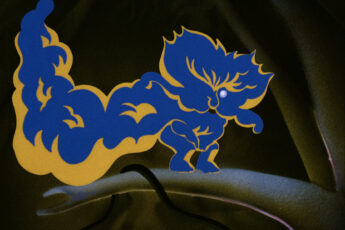
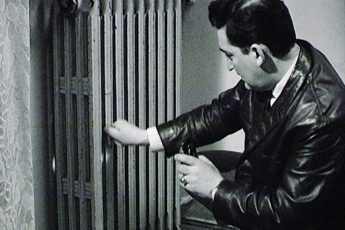

Leave a Comment